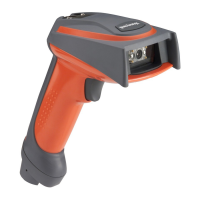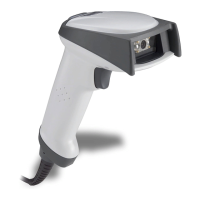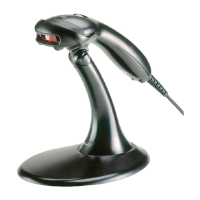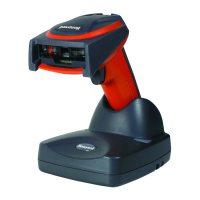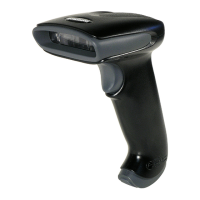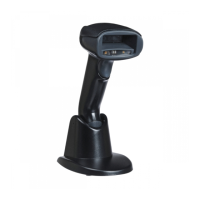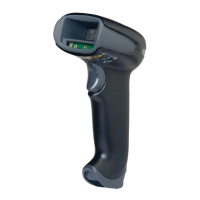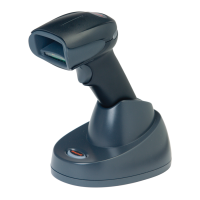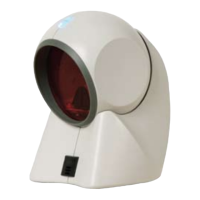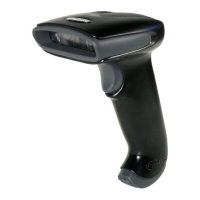Do you have a question about the Honeywell 4820i and is the answer not in the manual?
Provides an overview of the user's guide content and programming methods.
Step-by-step instructions for unpacking the cordless imaging system.
Lists available image scanner models and their descriptions.
Identifies the primary components of the cordless imaging system.
Information regarding the rechargeable battery, its use, and recommendations.
Guidelines for the environmentally sound disposal of batteries.
Describes how to connect the base to various host systems.
Instructions for connecting the base unit to a computer via a USB port.
Steps to connect the base using a keyboard wedge interface.
Instructions for connecting the base via an RS-232 serial port.
Procedure for establishing a link between the image scanner and the base.
Guidance on using the aiming beam and positioning for optimal bar code reads.
Using Plug and Play bar codes for instant scanner setup for common interfaces.
Programming for IBM PC AT and compatibles using a USA keyboard wedge.
Configuring the scanner for RS-232 serial port connection.
Setting up wand emulation with Code 39 or same code format.
Configuring for USB PC or Macintosh keyboard with CR/LF and Terminal ID.
Setting the scanner to emulate an RS-232 COM Port.
Setting up the serial wedge terminal ID and communication parameters.
Using Terminal IDs to program the scanner for specific PC interfaces.
Lists supported terminals with their corresponding Terminal IDs.
Scanning country codes to program the keyboard layout.
Programming keyboard styles like Caps Lock and Shift Lock.
Modifying special keyboard features like CTRL+ASCII codes and Turbo Mode.
Configuring the baud rate for RS-232 communication.
Configuring data transmission control using RS-232 handshaking.
Configuring the scanner to respond to host commands for data approval.
Configuration options for wand emulation mode.
Describes the function and components of the cordless base unit.
Details the three methods for supplying power to the base for battery charging.
Interprets the meaning of beeper and LED indicators for scanner and base status.
Procedure to unlink an image scanner from the base before linking a new one.
Allows linking up to 7 image scanners to a single base.
Assigning an image scanner to a work group for specific application settings.
Restores the current work group settings to factory defaults.
Connecting and using the scanner with Bluetooth devices like PCs and laptops.
Procedure to change the default Bluetooth PIN code for security.
Alarm settings for when the scanner is out of range of the base.
Enabling or disabling batch mode for storing scanned data when out of range.
Settings for beeper and LED indicators for successful reads.
Setting minimum time before scanner can read another bar code.
Activating the scanner via trigger press or serial command.
Scanner remains idle when Scan Stand symbol is visible.
Scanner uses ambient light to detect bar codes, LEDs turn on for read.
Capturing an image instead of reading a bar code when trigger is pressed.
Setting time period before scanner can read the same bar code again.
Adjusting LED and aimer brightness (Off, Low, High).
Narrowing field of view to ensure reading of intended bar codes.
Selecting between Full Omnidirectional and Quick Omnidirectional search modes.
Specifying a symbology as higher priority when multiple symbologies appear.
Configuring the order in which scanned bar code data is output.
Reading multiple symbols with a single trigger pull.
Adjusting image scanner's reading of Matrix symbols.
Setting scanner orientation for direction-sensitive codes.
Adding user-defined data before or after scanned bar code data.
Step-by-step guide to adding prefixes or suffixes to scanned data.
Procedures for clearing single or all prefixes/suffixes for a symbology.
Enabling transmission of function codes contained within scanned data.
Slowing data transmission to increase integrity.
Overview of changing scanner output and inserting characters.
Steps to add a primary or alternate data format.
Details commands for editing and managing data formats.
Choosing options for data output: Off, On but Not Required, On Required.
Using alternate formats for single bar code scans.
Lists available symbologies for bar code decoding.
Enabling or disabling all symbologies, or selecting specific ones.
Setting minimum and maximum lengths to reduce misreads.
Settings for Codabar symbology, including start/stop characters and check characters.
Settings for Code 39 symbology, including start/stop characters and check characters.
Configuring Code 39 check character validation and transmission.
Settings for Code 128 symbology, including ISBT 128 concatenation.
Settings for UPC-A symbology, including check digit and number system.
Adding 2 or 5 digits to the end of scanned UPC-A data.
Settings for UPC-E0 symbology, including expand, addenda, and number system.
Settings for EAN/JAN-13 symbology, including check digit.
Settings for EAN/JAN-8 symbology, including check digit.
Settings for MSI symbology, including check character.
Settings for Plessey Code symbology, including message length.
Settings for GS1 DataBar Omnidirectional symbology.
Settings for GS1 DataBar Limited symbology.
Settings for GS1 DataBar Expanded symbology, including message length.
Settings for PosiCode symbology, including message length.
Settings for Codablock F symbology, including message length.
Settings for Code 16K symbology, including message length.
Settings for Code 49 symbology, including message length.
Settings for PDF417 symbology, including message length.
Settings for MicroPDF417 symbology, including message length.
Enabling GS1 Composite Codes.
Emulating GS1 data carriers like GS1-128 or GS1 DataBar.
Settings for Intelligent Mail Bar Code symbology.
Decoding TLC39 composite codes, enabling MicroPDF417 component.
Notes on reading postal symbologies and disabling others for performance.
Settings for ID-tag (UPU 4-State) symbology.
Settings for Postnet symbology, including check digit.
Settings for Planet Code symbology, including check digit.
Settings for British Post symbology.
Settings for Canadian Post symbology.
Note on Kix code misreads and using Working Orientation.
Settings for Australian Post symbology.
Settings for China Post symbology, including message length.
Settings for Korea Post symbology, including message length.
Settings for QR Code symbology, including message length.
Settings for Data Matrix symbology, including message length.
Settings for MaxiCode symbology, including message length.
Settings for Aztec Code symbology, including message length and runes.
Settings for Chinese Sensible (Han Xin) Code symbology, including message length.
Sending instructions for single image captures that revert to defaults.
Format for issuing imaging commands with modifiers and sequences.
Capturing an image using the IMGSNP command and its modifiers.
Options for Image Snap style, beeper, and trigger behavior.
Setting exposure time for image capture, similar to camera shutter speed.
Adjusting gain to boost signal and pixel value, amplifying noise.
Setting target grayscale value for captured image quality.
Specifying the desired file format for saving images.
Rotating the image around the X or Y axis.
Setting desired quality for JPEG format, affecting file size and compression.
Adjusting image brightness by brightening or darkening.
Specifying image window by pixel coordinates for left, right, top, bottom.
Configuring signature capture area size and location relative to bar codes.
Options to adjust image width, height, pixel depth for IMGBOX.
Settings for OCR capability, fonts, and templates.
Creating custom templates for defining length and content of OCR strings.
Programming scanner to read character combinations in a specified order.
Using specific characters in templates for precise matching.
Creating up to two user variables for OCR templates.
Programming the scanner to print and verify check characters for OCR security.
Customizing check character calculation for specific applications.
Steps to program a user-defined check character calculation.
Using weighted modulo 10 schemes for check character computation.
Configuring the scanner to read ISBN characters on books.
Mapping keyboard function codes, HEX/ASCII values, and Full ASCII CTRL+ relationships.
Lists interface key mappings for various terminal types.
Causes the image scanner to re-link with the base.
Restores the current work group settings to factory defaults.
Resets all work groups to factory default settings.
Overview of PC-based functions for imager programming and upgrades.
Microsoft Windows program for displaying decoded symbols and capturing images.
Instructions for downloading and installing QuickView software.
Explains the syntax for menu and query command descriptions.
Special characters used to query device settings.
Examples demonstrating how to query device settings using commands.
Activating and deactivating the scanner using serial trigger commands.
Table listing selections, settings, serial commands, and pages for menu configurations.
Detailed technical specifications for the 4820 model.
Detailed technical specifications for the 4820i model.
Detailed technical specifications for the 2020-5 model.
Pinout details for the 10 Pin RJ41 Modular Plug used in keyboard wedge connections.
Pinout details for 9 Pin Type D Female and 10 Pin Modular Plug connectors for wand emulation.
Pinout details for the 10 Pin RJ41 Modular Plug used in serial output connections.
Pinout details for the 10 Pin Modular Plug used in USB connections.
Instructions for cleaning the image scanner window, housing, and base.
Procedure for removing and replacing the image scanner battery.
Instructions for attaching the tether and inserting the battery into the charge sleeve.
Placing the battery charge sleeve into the base for charging.
Guidelines for diagnosing and resolving issues with the base unit.
Steps to troubleshoot issues with the image scanner, including symbol reading.
Contact methods for installation, troubleshooting, and support.
Information on obtaining warranty or non-warranty service globally.
Details of Honeywell's product warranty terms and conditions.
Table mapping symbologies to AIM IDs, modifiers, and Code IDs.
Mapping of DEC, HEX, and Character codes for U.S. style keyboards.
Mapping of character codes to characters for different code pages.
Controlling automatic re-linking behavior after connection loss.
Setting the number of connection attempts to a base unit or PC.
Controlling idle time between re-link attempts.
Examples illustrating default and custom Bluetooth/ISM network activity settings.
Provides an overview of the user's guide content and programming methods.
Step-by-step instructions for unpacking the cordless imaging system.
Lists available image scanner models and their descriptions.
Identifies the primary components of the cordless imaging system.
Information regarding the rechargeable battery, its use, and recommendations.
Guidelines for the environmentally sound disposal of batteries.
Describes how to connect the base to various host systems.
Instructions for connecting the base unit to a computer via a USB port.
Steps to connect the base using a keyboard wedge interface.
Instructions for connecting the base via an RS-232 serial port.
Procedure for establishing a link between the image scanner and the base.
Guidance on using the aiming beam and positioning for optimal bar code reads.
Using Plug and Play bar codes for instant scanner setup for common interfaces.
Programming for IBM PC AT and compatibles using a USA keyboard wedge.
Configuring the scanner for RS-232 serial port connection.
Setting up wand emulation with Code 39 or same code format.
Configuring for USB PC or Macintosh keyboard with CR/LF and Terminal ID.
Setting the scanner to emulate an RS-232 COM Port.
Setting up the serial wedge terminal ID and communication parameters.
Using Terminal IDs to program the scanner for specific PC interfaces.
Lists supported terminals with their corresponding Terminal IDs.
Scanning country codes to program the keyboard layout.
Programming keyboard styles like Caps Lock and Shift Lock.
Modifying special keyboard features like CTRL+ASCII codes and Turbo Mode.
Configuring the baud rate for RS-232 communication.
Configuring data transmission control using RS-232 handshaking.
Configuring the scanner to respond to host commands for data approval.
Configuration options for wand emulation mode.
Describes the function and components of the cordless base unit.
Details the three methods for supplying power to the base for battery charging.
Interprets the meaning of beeper and LED indicators for scanner and base status.
Procedure to unlink an image scanner from the base before linking a new one.
Allows linking up to 7 image scanners to a single base.
Assigning an image scanner to a work group for specific application settings.
Restores the current work group settings to factory defaults.
Connecting and using the scanner with Bluetooth devices like PCs and laptops.
Procedure to change the default Bluetooth PIN code for security.
Alarm settings for when the scanner is out of range of the base.
Enabling or disabling batch mode for storing scanned data when out of range.
Settings for beeper and LED indicators for successful reads.
Setting minimum time before scanner can read another bar code.
Activating the scanner via trigger press or serial command.
Scanner remains idle when Scan Stand symbol is visible.
Scanner uses ambient light to detect bar codes, LEDs turn on for read.
Capturing an image instead of reading a bar code when trigger is pressed.
Setting time period before scanner can read the same bar code again.
Adjusting LED and aimer brightness (Off, Low, High).
Narrowing field of view to ensure reading of intended bar codes.
Selecting between Full Omnidirectional and Quick Omnidirectional search modes.
Specifying a symbology as higher priority when multiple symbologies appear.
Configuring the order in which scanned bar code data is output.
Reading multiple symbols with a single trigger pull.
Adjusting image scanner's reading of Matrix symbols.
Setting scanner orientation for direction-sensitive codes.
Adding user-defined data before or after scanned bar code data.
Step-by-step guide to adding prefixes or suffixes to scanned data.
Procedures for clearing single or all prefixes/suffixes for a symbology.
Enabling transmission of function codes contained within scanned data.
Slowing data transmission to increase integrity.
Overview of changing scanner output and inserting characters.
Steps to add a primary or alternate data format.
Details commands for editing and managing data formats.
Choosing options for data output: Off, On but Not Required, On Required.
Using alternate formats for single bar code scans.
Lists available symbologies for bar code decoding.
Enabling or disabling all symbologies, or selecting specific ones.
Setting minimum and maximum lengths to reduce misreads.
Settings for Codabar symbology, including start/stop characters and check characters.
Settings for Code 39 symbology, including start/stop characters and check characters.
Configuring Code 39 check character validation and transmission.
Settings for Code 128 symbology, including ISBT 128 concatenation.
Settings for UPC-A symbology, including check digit and number system.
Adding 2 or 5 digits to the end of scanned UPC-A data.
Settings for UPC-E0 symbology, including expand, addenda, and number system.
Settings for EAN/JAN-13 symbology, including check digit.
Settings for EAN/JAN-8 symbology, including check digit.
Settings for MSI symbology, including check character.
Settings for Plessey Code symbology, including message length.
Settings for GS1 DataBar Omnidirectional symbology.
Settings for GS1 DataBar Limited symbology.
Settings for GS1 DataBar Expanded symbology, including message length.
Settings for PosiCode symbology, including message length.
Settings for Codablock F symbology, including message length.
Settings for Code 16K symbology, including message length.
Settings for Code 49 symbology, including message length.
Settings for PDF417 symbology, including message length.
Settings for MicroPDF417 symbology, including message length.
Enabling GS1 Composite Codes.
Emulating GS1 data carriers like GS1-128 or GS1 DataBar.
Settings for Intelligent Mail Bar Code symbology.
Decoding TLC39 composite codes, enabling MicroPDF417 component.
Notes on reading postal symbologies and disabling others for performance.
Settings for ID-tag (UPU 4-State) symbology.
Settings for Postnet symbology, including check digit.
Settings for Planet Code symbology, including check digit.
Settings for British Post symbology.
Settings for Canadian Post symbology.
Note on Kix code misreads and using Working Orientation.
Settings for Australian Post symbology.
Settings for China Post symbology, including message length.
Settings for Korea Post symbology, including message length.
Settings for QR Code symbology, including message length.
Settings for Data Matrix symbology, including message length.
Settings for MaxiCode symbology, including message length.
Settings for Aztec Code symbology, including message length and runes.
Settings for Chinese Sensible (Han Xin) Code symbology, including message length.
Sending instructions for single image captures that revert to defaults.
Format for issuing imaging commands with modifiers and sequences.
Capturing an image using the IMGSNP command and its modifiers.
Options for Image Snap style, beeper, and trigger behavior.
Setting exposure time for image capture, similar to camera shutter speed.
Adjusting gain to boost signal and pixel value, amplifying noise.
Setting target grayscale value for captured image quality.
Specifying the desired file format for saving images.
Rotating the image around the X or Y axis.
Setting desired quality for JPEG format, affecting file size and compression.
Adjusting image brightness by brightening or darkening.
Specifying image window by pixel coordinates for left, right, top, bottom.
Configuring signature capture area size and location relative to bar codes.
Options to adjust image width, height, pixel depth for IMGBOX.
Settings for OCR capability, fonts, and templates.
Creating custom templates for defining length and content of OCR strings.
Programming scanner to read character combinations in a specified order.
Using specific characters in templates for precise matching.
Creating up to two user variables for OCR templates.
Programming the scanner to print and verify check characters for OCR security.
Customizing check character calculation for specific applications.
Steps to program a user-defined check character calculation.
Using weighted modulo 10 schemes for check character computation.
Configuring the scanner to read ISBN characters on books.
Mapping keyboard function codes, HEX/ASCII values, and Full ASCII CTRL+ relationships.
Lists interface key mappings for various terminal types.
Causes the image scanner to re-link with the base.
Restores the current work group settings to factory defaults.
Resets all work groups to factory default settings.
Overview of PC-based functions for imager programming and upgrades.
Microsoft Windows program for displaying decoded symbols and capturing images.
Instructions for downloading and installing QuickView software.
Explains the syntax for menu and query command descriptions.
Special characters used to query device settings.
Examples demonstrating how to query device settings using commands.
Activating and deactivating the scanner using serial trigger commands.
Table listing selections, settings, serial commands, and pages for menu configurations.
Detailed technical specifications for the 4820 model.
Detailed technical specifications for the 4820i model.
Detailed technical specifications for the 2020-5 model.
Pinout details for the 10 Pin RJ41 Modular Plug used in keyboard wedge connections.
Pinout details for 9 Pin Type D Female and 10 Pin Modular Plug connectors for wand emulation.
Pinout details for the 10 Pin RJ41 Modular Plug used in serial output connections.
Pinout details for the 10 Pin Modular Plug used in USB connections.
Instructions for cleaning the image scanner window, housing, and base.
Procedure for removing and replacing the image scanner battery.
Instructions for attaching the tether and inserting the battery into the charge sleeve.
Placing the battery charge sleeve into the base for charging.
Guidelines for diagnosing and resolving issues with the base unit.
Steps to troubleshoot issues with the image scanner, including symbol reading.
Contact methods for installation, troubleshooting, and support.
Information on obtaining warranty or non-warranty service globally.
Details of Honeywell's product warranty terms and conditions.
Table mapping symbologies to AIM IDs, modifiers, and Code IDs.
Mapping of DEC, HEX, and Character codes for U.S. style keyboards.
Mapping of character codes to characters for different code pages.
Controlling automatic re-linking behavior after connection loss.
Setting the number of connection attempts to a base unit or PC.
Controlling idle time between re-link attempts.
Examples illustrating default and custom Bluetooth/ISM network activity settings.
| Brand | Honeywell |
|---|---|
| Model | 4820i |
| Category | Barcode Reader |
| Language | English |

